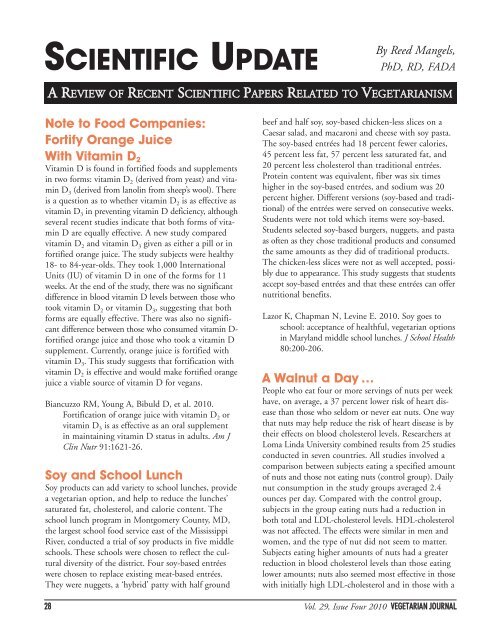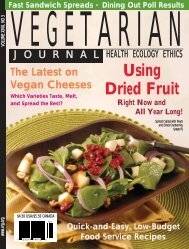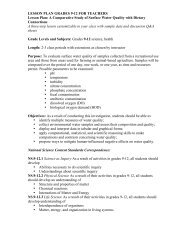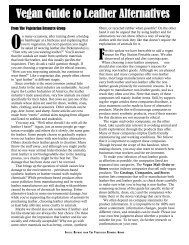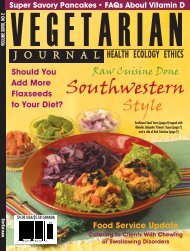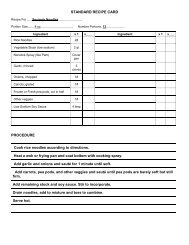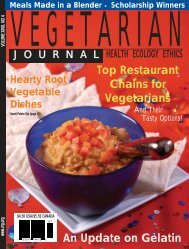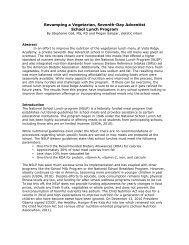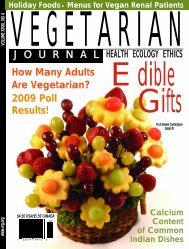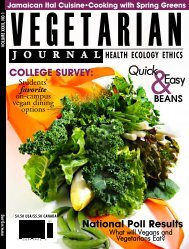Vegetarian Journal - Issue 4 2010 - The Vegetarian Resource Group
Vegetarian Journal - Issue 4 2010 - The Vegetarian Resource Group
Vegetarian Journal - Issue 4 2010 - The Vegetarian Resource Group
- No tags were found...
You also want an ePaper? Increase the reach of your titles
YUMPU automatically turns print PDFs into web optimized ePapers that Google loves.
SCIENTIFIC UPDATEBy Reed Mangels,PhD, RD, FADAA REVIEW OF RECENT SCIENTIFIC PAPERS RELATED TO VEGETARIANISMNote to Food Companies:Fortify Orange JuiceWith Vitamin D 2Vitamin D is found in fortified foods and supplementsin two forms: vitamin D 2 (derived from yeast) and vitaminD 3 (derived from lanolin from sheep’s wool). <strong>The</strong>reis a question as to whether vitamin D 2 is as effective asvitamin D 3 in preventing vitamin D deficiency, althoughseveral recent studies indicate that both forms of vitaminD are equally effective. A new study comparedvitamin D 2 and vitamin D 3 given as either a pill or infortified orange juice. <strong>The</strong> study subjects were healthy18- to 84-year-olds. <strong>The</strong>y took 1,000 InternationalUnits (IU) of vitamin D in one of the forms for 11weeks. At the end of the study, there was no significantdifference in blood vitamin D levels between those whotook vitamin D 2 or vitamin D 3 , suggesting that bothforms are equally effective. <strong>The</strong>re was also no significantdifference between those who consumed vitamin D-fortified orange juice and those who took a vitamin Dsupplement. Currently, orange juice is fortified withvitamin D 3 . This study suggests that fortification withvitamin D 2 is effective and would make fortified orangejuice a viable source of vitamin D for vegans.Biancuzzo RM, Young A, Bibuld D, et al. <strong>2010</strong>.Fortification of orange juice with vitamin D 2 orvitamin D 3 is as effective as an oral supplementin maintaining vitamin D status in adults. Am JClin Nutr 91:1621-26.Soy and School LunchSoy products can add variety to school lunches, providea vegetarian option, and help to reduce the lunches’saturated fat, cholesterol, and calorie content. <strong>The</strong>school lunch program in Montgomery County, MD,the largest school food service east of the MississippiRiver, conducted a trial of soy products in five middleschools. <strong>The</strong>se schools were chosen to reflect the culturaldiversity of the district. Four soy-based entréeswere chosen to replace existing meat-based entrées.<strong>The</strong>y were nuggets, a ‘hybrid’ patty with half groundbeef and half soy, soy-based chicken-less slices on aCaesar salad, and macaroni and cheese with soy pasta.<strong>The</strong> soy-based entrées had 18 percent fewer calories,45 percent less fat, 57 percent less saturated fat, and20 percent less cholesterol than traditional entrées.Protein content was equivalent, fiber was six timeshigher in the soy-based entrées, and sodium was 20percent higher. Different versions (soy-based and traditional)of the entrées were served on consecutive weeks.Students were not told which items were soy-based.Students selected soy-based burgers, nuggets, and pastaas often as they chose traditional products and consumedthe same amounts as they did of traditional products.<strong>The</strong> chicken-less slices were not as well accepted, possiblydue to appearance. This study suggests that studentsaccept soy-based entrées and that these entrées can offernutritional benefits.Lazor K, Chapman N, Levine E. <strong>2010</strong>. Soy goes toschool: acceptance of healthful, vegetarian optionsin Maryland middle school lunches. J School Health80:200-206.A Walnut a Day …People who eat four or more servings of nuts per weekhave, on average, a 37 percent lower risk of heart diseasethan those who seldom or never eat nuts. One waythat nuts may help reduce the risk of heart disease is bytheir effects on blood cholesterol levels. Researchers atLoma Linda University combined results from 25 studiesconducted in seven countries. All studies involved acomparison between subjects eating a specified amountof nuts and those not eating nuts (control group). Dailynut consumption in the study groups averaged 2.4ounces per day. Compared with the control group,subjects in the group eating nuts had a reduction inboth total and LDL-cholesterol levels. HDL-cholesterolwas not affected. <strong>The</strong> effects were similar in men andwomen, and the type of nut did not seem to matter.Subjects eating higher amounts of nuts had a greaterreduction in blood cholesterol levels than those eatinglower amounts; nuts also seemed most effective in thosewith initially high LDL-cholesterol and in those with a28 Vol. 29, <strong>Issue</strong> Four <strong>2010</strong> VEGETARIAN JOURNAL


